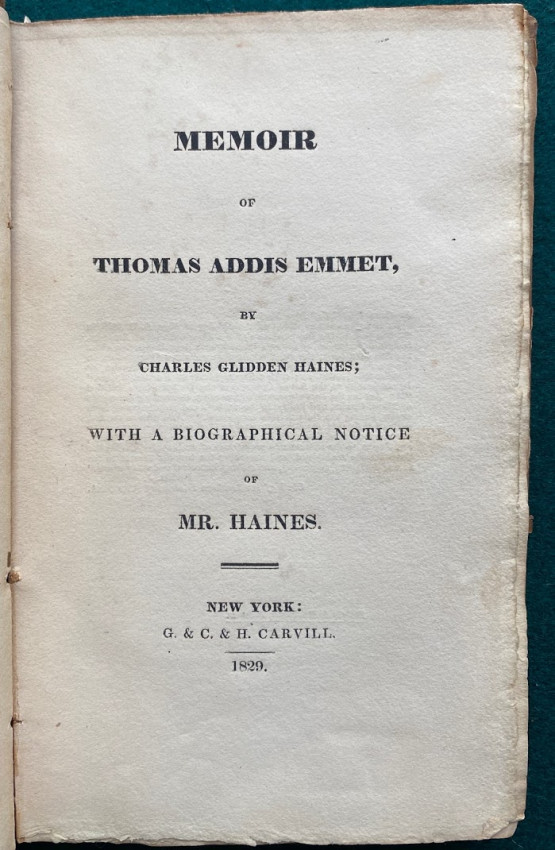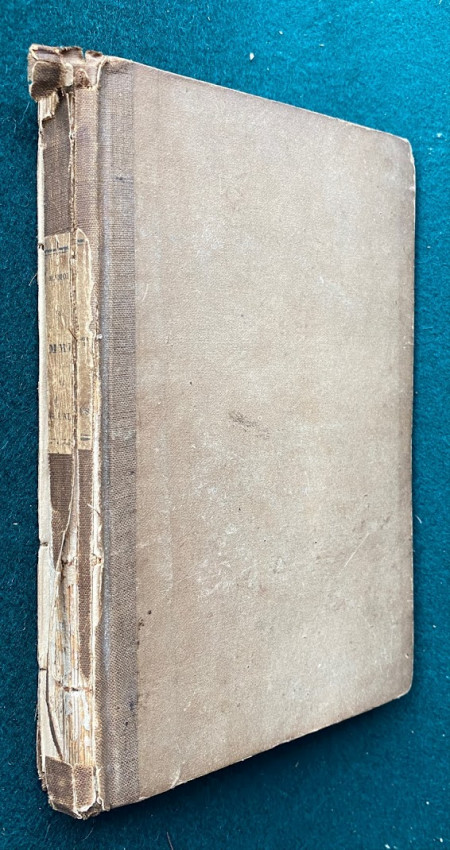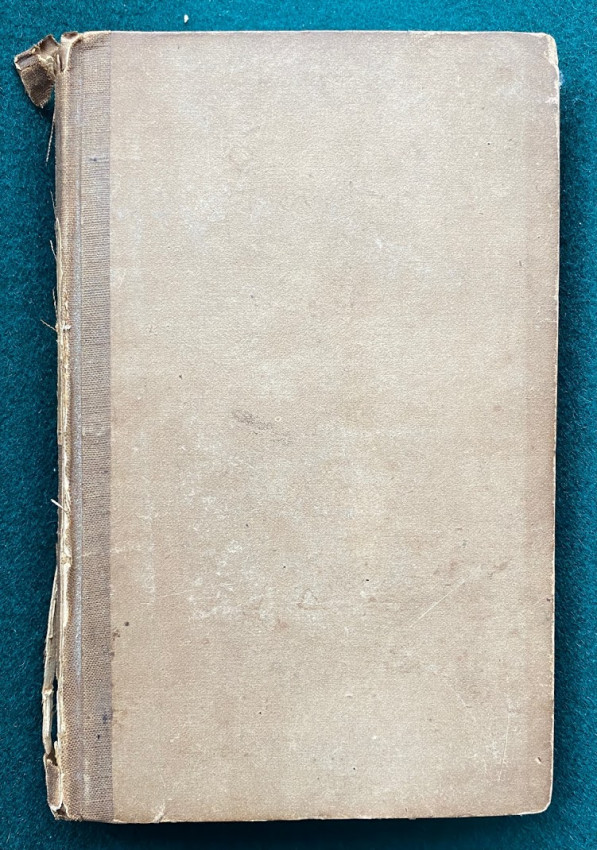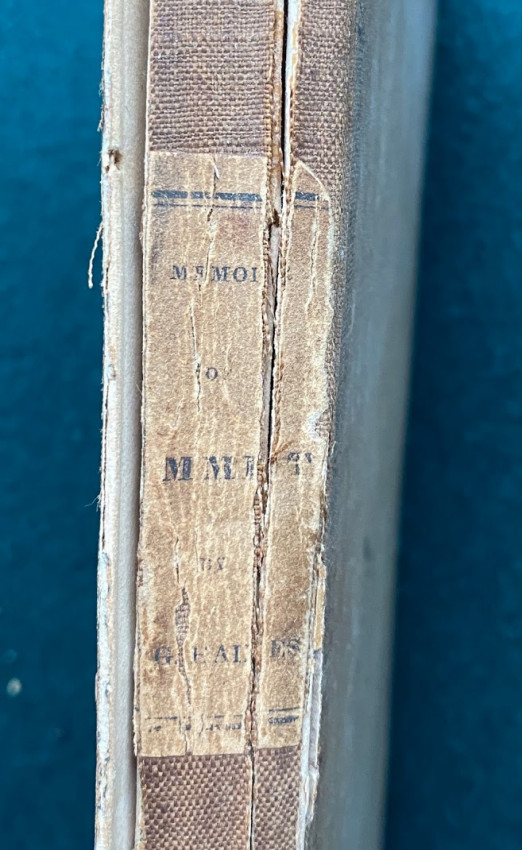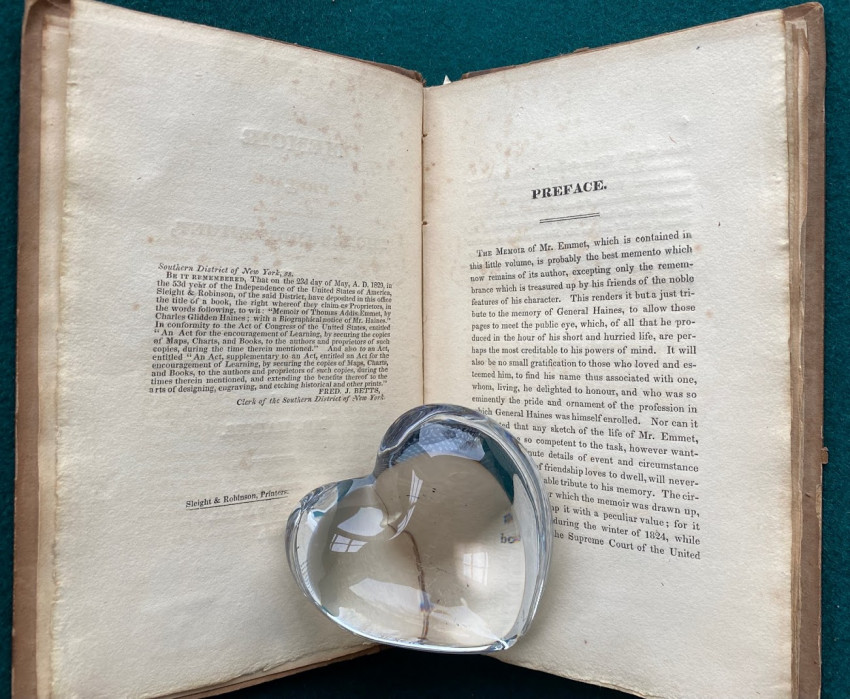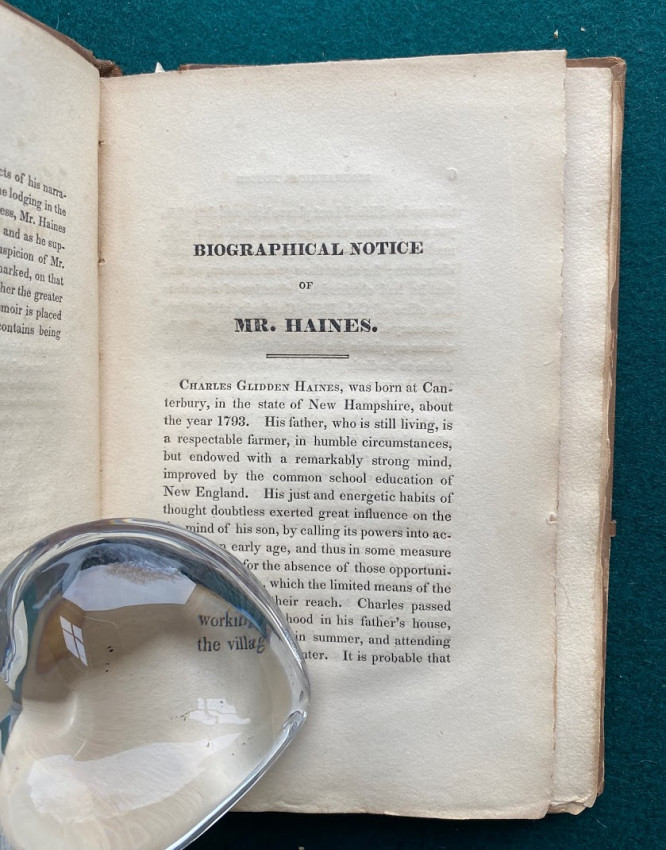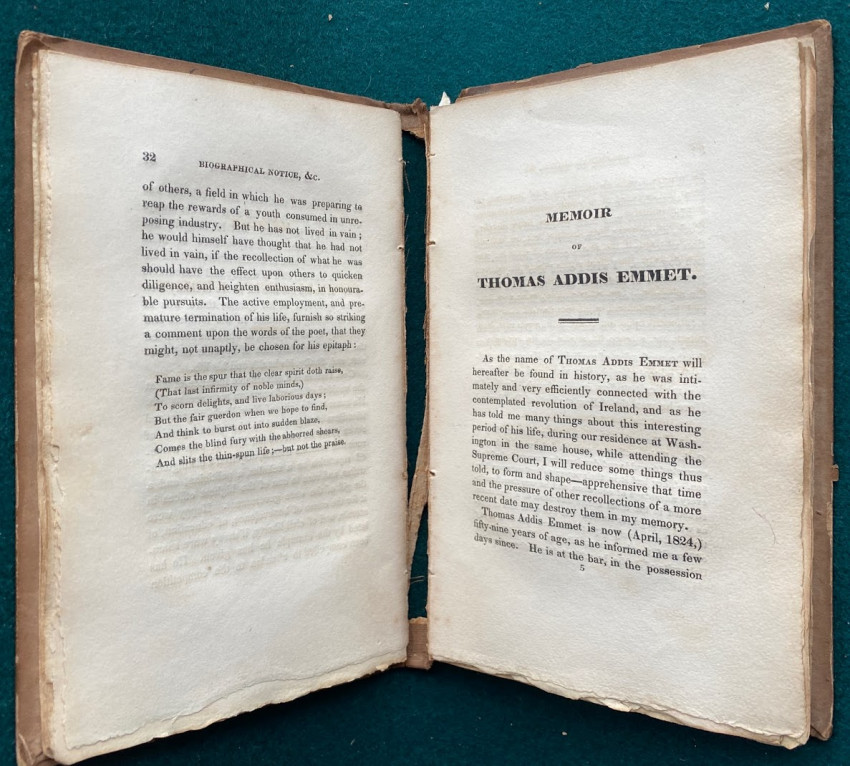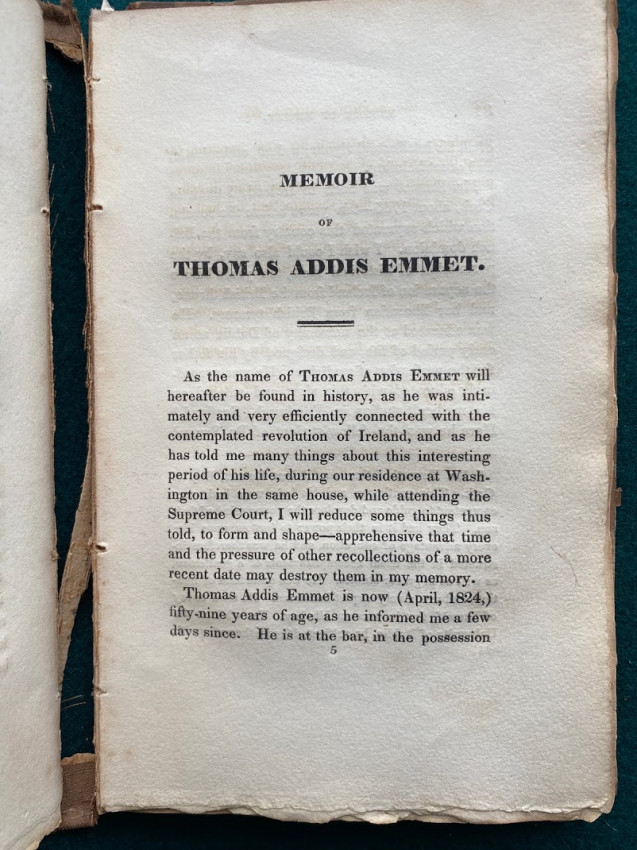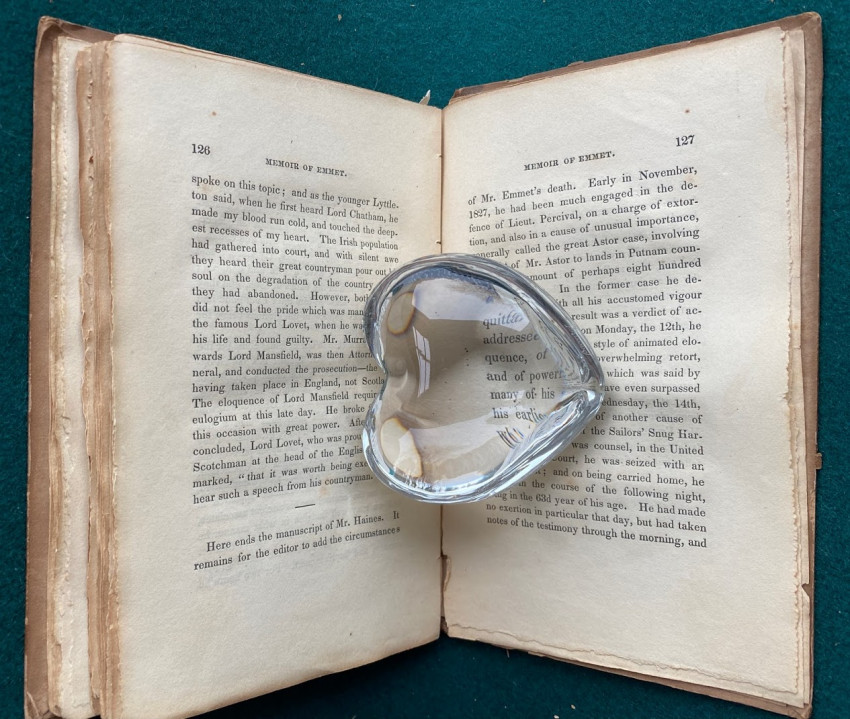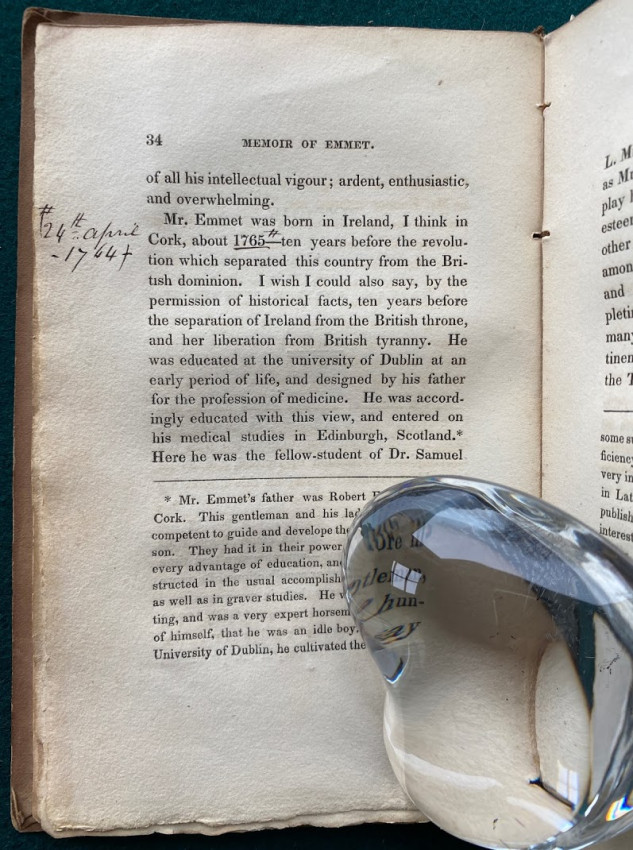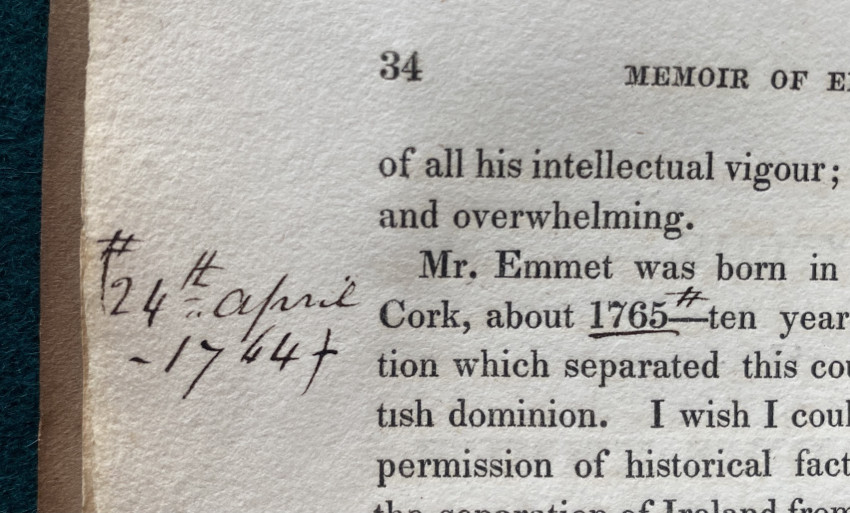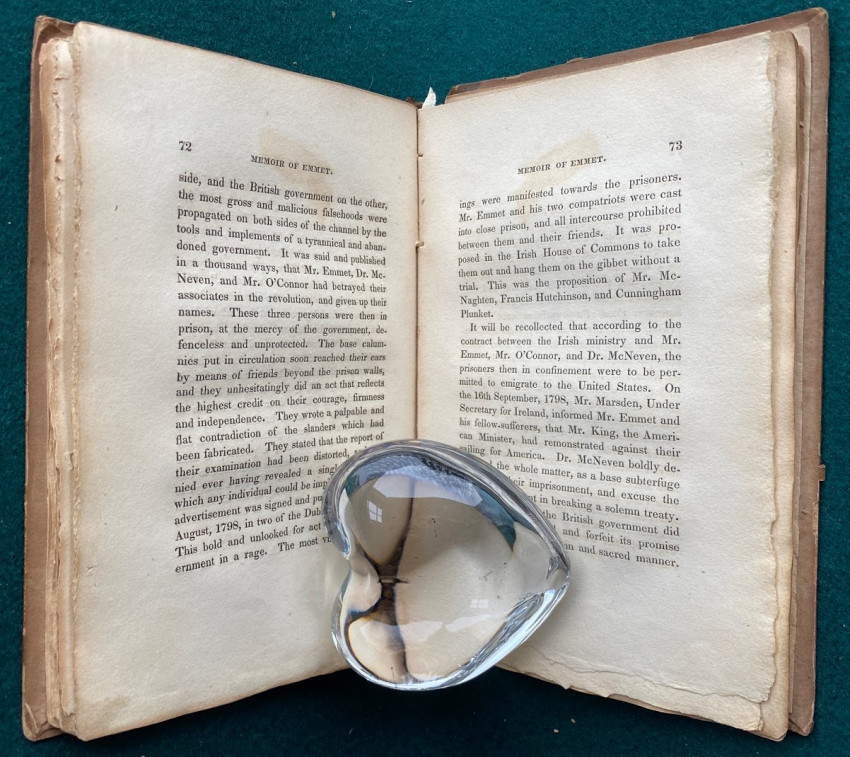IRISH FREEDOM Fighters. - Charles Glidden HAINES (1793–1825)
Memoir of Thomas Addis Emmet, by ... Haines; with a biographical notice of Mr. Haines. New York: [printed by Sleight & Robinson for ] G. & C. & H. Carvill, 1829. 12mo signed in sixes (6 3/4 x 4 1/4in; 172 x 107mm). Pp. [1-]132. Original cloth-backed boards, paper label to backstrip, uncut (stitching broken, covers detached, backstrip split and defective [see images)]. Provenance: Emmet family (by descent, n.b. ink marginal correction p.34, and pencilled correction p.74).
A friend remembers a friend – an Irish-born fighter for freedom. The brother of an Irish martyr, he was forced to abandon his homeland but came to personify the realization of the American Dream.
'Thomas Addis Emmet (24 April 1764 – 14 November 1827) was an Irish and American lawyer and politician. He was a senior member of the revolutionary republican group United Irishmen in the 1790s and New York State Attorney General 1812–1813.
Thomas Addis Emmet was born in the Hammond's Marsh area of Cork City on 24 April 1764. He was a son of Dr. Robert Emmet from Tipperary (later to become State Physician of Ireland) and Elizabeth Mason of Kerry, both of whose portraits are today displayed at Cork's Crawford Art Gallery. He was the elder brother of Robert Emmet, who was himself executed for leading the Irish Rebellion of 1803, becoming one of Ireland's most famous Republican martyrs. His sister, Mary Anne Holmes, held similar political beliefs.Emmet was educated at Trinity College, Dublin and was a member of the committee of the College Historical Society. He later studied medicine at the University of Edinburgh and was a pupil of Dugald Stewart in philosophy. After visiting the chief medical schools on the continent, he returned to Ireland in 1788; but the sudden death of his elder brother, Christopher Temple Emmet (1761–1788), a student of great distinction, induced him to follow the advice of Sir James Mackintosh to forsake medicine for the law as a profession.
Emmet was a man of liberal political sympathies and became involved with campaign to extend the democratic franchise for the Irish Parliament and to end discrimination against Catholics. He was called to the Irish bar in 1790 and quickly obtained a practice, principally as counsel for prisoners charged with political offenses. He also became the legal adviser of the Society of the United Irishmen.
When the Dublin Corporation issued a declaration of support of the Protestant Ascendancy in 1792, the response of the United Irishmen was their non-sectarian manifesto which was largely drawn up by Emmet. In 1795 he formally took the oath of the United Irishmen, becoming secretary in the same year and a member of the executive in 1797. As by this time the United Irishmen had been declared illegal and driven underground, any efforts at peaceful reform of government and Catholic emancipation in Ireland were abandoned as futile, and their goal was now the creation of a non-sectarian Irish republic, independent from Britain and to be achieved by armed rebellion. Although Emmet supported this policy, he believed that the rebellion should not commence until French aid had arrived, differing from more radical members such as Lord Edward Fitzgerald.
British intelligence had infiltrated the United Irishmen and managed to arrest most of their leaders on the eve of the rebellion. Though not among those taken at the house of Oliver Bond on 12 March 1798 (see Lord Edward Fitzgerald), he was arrested about the same time, and was one of the leaders imprisoned initially at Kilmainham Jail and later in Scotland at Fort George until 1802. Upon his release he went to Brussels where he was visited by his brother Robert Emmet in October 1802 and was informed of the preparations for a fresh rising in Ireland in conjunction with French aid. However, at that stage France and Britain were briefly at peace, and the Emmets' pleas for help were turned down by Napoleon.
He received news of the failure of Robert Emmet's rising in July 1803 in Paris, where he was in communication with Napoleon Bonaparte. He then emigrated to the United States and joined the New York bar where he obtained a lucrative practice.
After the death of Matthias B. Hildreth, he was appointed New York State Attorney General in August 1812, but was removed from office in February 1813 when the opposing Federalist Party obtained a majority in the Council of Appointment.
His abilities and successes became so acclaimed and his services so requested that he became one of the most respected attorneys in the nation, with United States Supreme Court Justice Joseph Story declaring him to be "the favourite counsellor of New York."[3] He argued the case for Ogden in the landmark United States Supreme Court case of Gibbons v. Ogden, 22 U.S. 1 (1824) relating to the Commerce and Supremacy clauses of the United States Constitution.
He married Jane Patten (1771–1846), a daughter of John Patten and Jane (née Colville) Patten, in 1791.[4] Together, they were the parents of:
Robert Emmet, who was born in Dublin and became prominent a New York jurist and Irish American activist.
Elizabeth Emmet (1794–1878), who married William Henry LeRoy (1795–1888), a brother-in-law of Daniel Webster.
Margaret Emmet (1794–1883), who did not marry.
John Patten Emmet (1795–1842), who married Mary Byrd Tucker (1805–1860) in 1827; their daughter, Jane Emmet, married merchant John Noble Alsop Griswold.
Thomas Addis Emmet (1797–1863), who married Anna Riker Thom (1805–1886), daughter of John Thom and Jane Margaret Riker.
Jane Erin Emmet (1802–1890), who married Bache McEvers in 1825. Their daughter Mary Bache McEvers married Sir Edward Cunard, 2nd Baronet (son of Sir Samuel Cunard, 1st Baronet, founder of the Cunard Line).
Samuel F. B. Morse painted a famous portrait of Emmet that Maxwell kept. Upon Maxwell's death in 1873, he left the painting to the New York Law Institute, which was exhibited in the National Portrait Gallery and was auctioned by Sotheby's in 2010.
Emmet died on 14 November 1827 while conducting a case in court regarding the estate of Robert Richard Randall, the founder of Sailors' Snug Harbor, a home for needy seamen in Staten Island, New York. He was initially buried in St Mark's-in-the-Bowery Churchyard in the East Village, New York City.
Through his son Robert, he was a grandfather of another prominent New York jurist and attorney general, Richard Stockton Emmet (himself the father of Richard S. Emmet Jr.), and great-grandfather of the notable American portrait artist sisters Rosina Emmet Sherwood, Lydia Field Emmet and Jane Emmet de Glehn, as well as their first cousin Ellen Emmet Rand. Rosina's twin brother was West Point graduate and Medal of Honor winner Robert Temple Emmet. He is the great-great-grandfather of the playwright Robert Emmet Sherwood. His direct descendant, French human rights lawyer Valentin Ribet, died aged 26 in the terrorist attack on the Bataclan in Paris on Friday 13 November 2015.
His grandson, Dr. Thomas Addis Emmet, a prominent doctor and Irish American activist, requested that he be re-buried in Ireland so he could "rest in the land from which my family came." Dr Emmet was then interred in Glasnevin Cemetery in Dublin, the final resting place of many of Ireland's patriots, in 1922. His grave marker was designed by the father and brother of the revolutionary Patrick Pearse.
An obelisk to honor the memory of Emmet, mistaken by many to be a burial site, stands in St. Paul's Chapel's graveyard in Lower Manhattan.' (wikipedia)
Charles Haines , 'attorney and author, was a native of Canterbury, Merrimack County, New Hampshire. He worked as a government clerk in that state before graduating from Middlebury College in 1816. Thereafter Haines studied law, first in Vermont and later in New York City. A supporter of DeWitt Clinton, he became the governor’s private secretary at Albany. Haines was admitted to the New York bar in 1821. He wrote numerous political pamphlets and newspaper articles, and from 1822 to 1823 he collaborated with other lawyers in the publication of the United States Law Journal, and Civilian’s Magazine. Haines was admitted to the bar of the United States Supreme Court in 1824 and acted as cocounsel with Henry Clay in Ogden v. Saunders, a case involving the constitutionality of the New York state bankruptcy laws. Governor Clinton appointed him adjutant general for the state in 1825, but Haines died in New York City before taking office.' (https://founders.archives.gov/documents/Jefferson/03-13-02-0214)
- Binding Condition: Worn
- Overall Condition: Acceptable
- Size: 6 3/4 x 4 1/4in; 172 x 107mm
- Sold By: Shadowrock Rare Books
- Contact Person: Adam Langlands
- Country: United States
- Email: [email protected]
- Telephone: 001-860-248-1547
- Preferred Payment Methods: Paypal, US$ checks and wire transfers, major credit cards through paypal
- Trade Associations: AA Approved


